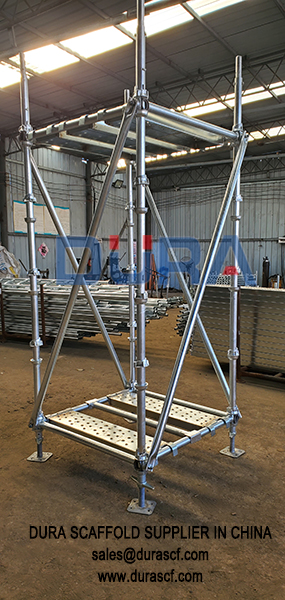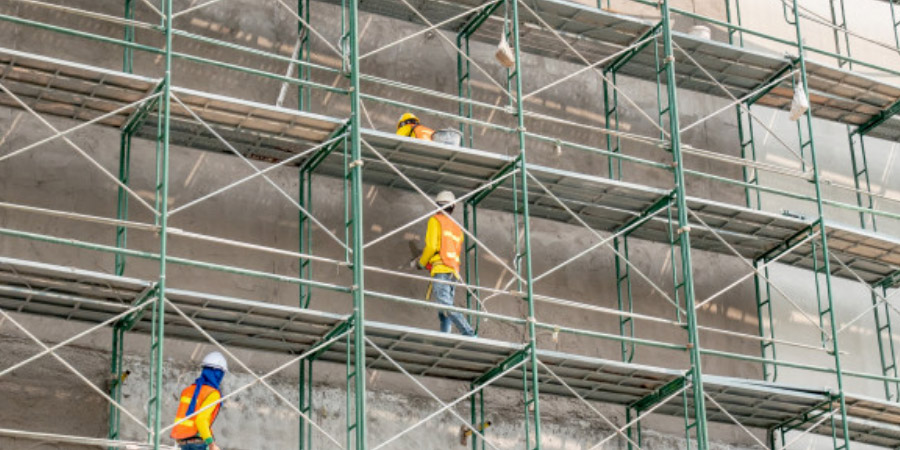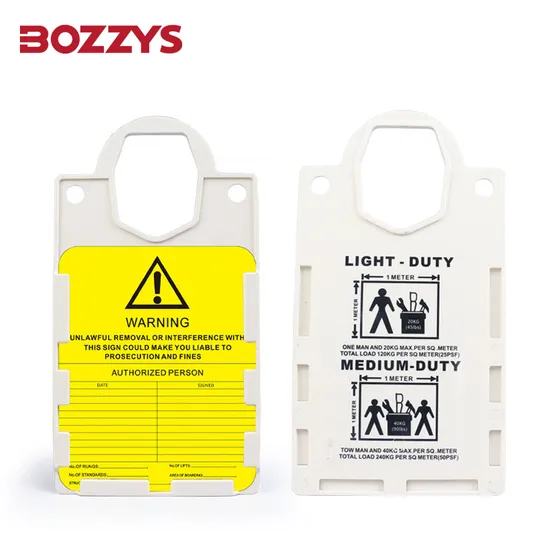Scaffolding is essential in construction. It provides safe access to high areas.
In Saudi Arabia, scaffolding plays a vital role in the booming construction industry. The types of scaffolding used here vary to meet different project needs and safety standards. Understanding these types helps in making the right choice for any construction job.
Whether you’re a contractor or a worker, knowing the different scaffolding types can ensure safety and efficiency. This guide will explore the various types of scaffolding available in Saudi Arabia. From traditional to modern systems, each type has unique features and benefits. Let’s dive in and learn more about the scaffolding options you might encounter in Saudi Arabia.

Credit: www.durascf.com
Introduction To Scaffolding
Scaffolding is crucial in construction projects. It provides a temporary structure to support workers and materials. Understanding its types is essential for safety and efficiency.
Importance In Construction
Scaffolding ensures workers can access hard-to-reach areas. It supports building, maintenance, and repair tasks. Proper scaffolding leads to better work quality and faster project completion. It also reduces workplace accidents.
Safety Considerations
Safety is a top priority in scaffolding. Choosing the right type is vital. Scaffolding must be stable and strong. Regular inspection and maintenance are necessary. Workers should use harnesses and helmets. Training on proper use can prevent accidents.
Scaffolding Regulations In Saudi Arabia
Scaffolding safety is crucial in Saudi Arabia. Strict regulations ensure worker safety. Understanding these rules helps avoid penalties and accidents.
Government Guidelines
The Saudi government has clear scaffolding guidelines. These rules cover design, construction, and use. Compliance is mandatory for all projects. Inspectors enforce these regulations strictly. Violations can result in heavy fines or project shutdowns.
Workers must receive proper training. Training includes safe assembly and disassembly of scaffolding. Regular inspections by qualified personnel are also mandatory. These inspections identify potential hazards early. Prompt corrective actions can then be taken.
Industry Standards
Industry standards complement government guidelines. Organizations like the Saudi Standards, Metrology, and Quality Organization (SASO) set these standards. They ensure scaffolding materials meet quality and safety criteria. Using substandard materials is not allowed.
Companies often adopt international standards. These include regulations from the Occupational Safety and Health Administration (OSHA). Following these standards enhances overall safety. It also boosts the credibility of construction firms.
Supported Scaffolding
Supported scaffolding is a common type used in construction. This scaffolding provides stability and support. In Saudi Arabia, it is widely used for various projects. Supported scaffolding consists of several types. Two popular ones are Frame Scaffolding and Tube and Coupler Scaffolding. Understanding these types helps in choosing the right scaffolding for your project.
Frame Scaffolding
Frame scaffolding is easy to assemble. It consists of pre-formed frames and cross braces. Workers prefer this type for its simplicity. It is ideal for light to medium construction tasks. In Saudi Arabia, many small projects use frame scaffolding. Its modular design allows for quick setup and takedown. This scaffolding also offers flexibility. Workers can adjust its height easily. Frame scaffolding is cost-effective. It is also widely available.
Tube And Coupler Scaffolding
Tube and coupler scaffolding is versatile. It uses tubes and connectors to form the structure. This type suits complex construction projects. Workers can build various shapes and sizes. The scaffolding provides high stability. It is suitable for heavy loads. In Saudi Arabia, large-scale projects often use tube and coupler scaffolding. This type is strong and durable. It can withstand harsh weather conditions. Workers can also easily customize it. This makes it a popular choice.
Suspended Scaffolding
Suspended scaffolding is an essential part of many construction projects in Saudi Arabia. This type of scaffolding hangs from above using ropes or wires. Workers can adjust the platform to different heights as needed. Suspended scaffolding is often used for tasks like painting, window cleaning, and building repairs.
Swing Stage
The swing stage is a common type of suspended scaffolding. It consists of a platform supported by ropes or cables. The platform can move up and down, allowing workers to access various levels of a building. Swing stages are ideal for tasks that need frequent movement. They provide a stable and secure working area. This makes them popular for high-rise buildings.
Two-point Adjustable Suspension
The two-point adjustable suspension scaffold has two suspension points. These points are usually at each end of the platform. This setup allows the platform to be raised or lowered easily. Workers can adjust the height to suit their needs. This type of scaffolding is very flexible. It is commonly used for tasks like exterior building maintenance. It also offers a high level of safety.
Rolling Scaffolding
Rolling scaffolding is a popular type of scaffolding in Saudi Arabia. It is essential for projects requiring frequent movement. The structure comes with wheels, allowing easy relocation without dismantling. This type of scaffolding is ideal for tasks that span large areas.
Benefits Of Mobility
Mobility is the key advantage of rolling scaffolding. Workers can move it quickly across sites. This saves time and effort. The wheels lock to ensure stability when needed. This feature enhances safety during use. Rolling scaffolding also reduces the need for multiple setups. Thus, it increases productivity and efficiency.
Common Uses
Rolling scaffolding is common in various tasks. Painters and electricians use it frequently. It is also popular in maintenance work. Tasks involving ceilings benefit greatly from it. Cleaning high windows becomes easier with rolling scaffolding. It is also valuable in warehouse management. Workers can reach high shelves easily. Overall, it is versatile and useful in many fields.
Specialty Scaffolding
Specialty scaffolding in Saudi Arabia caters to unique construction needs. It offers solutions for complex structures and challenging environments. These scaffolds are designed for specific tasks and provide enhanced safety and efficiency.
Cantilever Scaffolding
Cantilever scaffolding is used where the ground is weak or obstructed. It supports platforms that extend out from the building, without ground support. This type is crucial for areas above busy streets or waterways.
- Used in areas with obstacles on the ground
- Supports platforms extending from the building
- Ideal for construction above busy areas
Pump Jack Scaffolding
Pump jack scaffolding is adjustable. It moves up and down along vertical poles. Workers can easily modify the height. This type is common in residential projects.
- Adjustable height for versatile use
- Easy to assemble and dismantle
- Common in residential construction
Specialty scaffolding provides tailored solutions. It ensures safety and efficiency in unique construction scenarios.
Scaffolding Materials
Scaffolding is essential for construction projects in Saudi Arabia. The choice of scaffolding material affects the safety and efficiency of the project. Different materials offer various benefits and suitability for specific tasks. Let’s explore the primary scaffolding materials used in Saudi Arabia.
Steel Scaffolding
Steel scaffolding is popular for its strength and durability. This type of scaffolding can support heavy loads, making it ideal for large construction projects. Steel scaffolding is resistant to wear and tear, which ensures long-term use. It is also fire-resistant, adding an extra layer of safety on construction sites.
Another advantage of steel scaffolding is its easy assembly and disassembly. Workers can quickly set up and take down steel scaffolding, saving time and labor costs. Steel scaffolding’s stability and robustness make it a reliable choice for various construction needs in Saudi Arabia.
Aluminum Scaffolding
Aluminum scaffolding is lightweight and easy to transport. Its portability makes it suitable for projects that require frequent relocation. Aluminum scaffolding is corrosion-resistant, which means it can withstand harsh weather conditions.
Despite being lightweight, aluminum scaffolding offers good stability. It is often used for smaller projects or tasks that require quick setup. The ease of handling aluminum scaffolding reduces the risk of worker injuries. This type of scaffolding is also cost-effective due to its reusable nature.

Credit: www.instagram.com
Choosing The Right Scaffolding
Choosing the right scaffolding in Saudi Arabia is vital for any construction project. The correct type of scaffolding ensures worker safety and project efficiency. Different projects have unique needs, making the selection process crucial.
Project Requirements
First, understand your project’s specific requirements. Assess the height and complexity of the structure. For tall buildings, suspended scaffolding might be best. For simpler projects, supported scaffolding could suffice. Ensure that the scaffolding type matches the construction tasks. This avoids unnecessary complications.
Cost Considerations
Next, consider the cost of scaffolding. Budget constraints often influence the choice. Calculate the total expense, including installation and maintenance. Cheaper options may seem attractive. But, they might compromise safety. Balancing cost and quality is essential. Always prioritize worker safety over minor savings.
Maintaining Scaffolding
Maintaining Scaffolding is essential for the safety and efficiency of any construction project in Saudi Arabia. Regular upkeep ensures the scaffolding remains in top condition, preventing accidents and costly delays. Here are some key aspects to consider:
Regular Inspections
Regular inspections are crucial for scaffolding maintenance. Inspect the scaffolding daily before use. Check for any visible damage or wear and tear. Ensure all connections and fittings are secure.
Use a checklist to cover all aspects of the scaffolding structure:
- Check for loose bolts and nuts
- Look for signs of rust or corrosion
- Inspect planks for cracks or defects
- Verify the stability of the base
Regular inspections help identify issues early, preventing accidents and project delays.
Repair And Replacement
Timely repair and replacement of damaged parts are vital. If any part of the scaffolding is damaged, repair it immediately. Replace irreparable components to ensure safety.
Common components that may need repair or replacement include:
| Component | Action |
|---|---|
| Planks | Replace if cracked or broken |
| Braces | Repair or replace if bent |
| Connectors | Replace if rusted or damaged |
Always use high-quality materials for repairs. This ensures the scaffolding remains strong and reliable. Keeping a stock of essential parts can speed up the repair process.
Future Of Scaffolding In Saudi Arabia
The construction industry in Saudi Arabia is growing fast. Scaffolding is a key part of this growth. The future of scaffolding in Saudi Arabia is bright. New technologies and sustainability trends are shaping this future.
Technological Advancements
Technological advancements are changing scaffolding. Modern systems are safer and more efficient. For example, automated scaffolding reduces human error. It also speeds up construction work.
3D printing is another innovation. It allows for custom scaffolding parts. These parts are accurate and fit perfectly. This reduces waste and saves time.
Sustainability Trends
Sustainability is becoming important in Saudi Arabia. The scaffolding industry is following this trend. Eco-friendly materials are being used more. These materials are reusable and reduce waste.
Another trend is energy-efficient scaffolding systems. These systems use less power. This reduces the carbon footprint of construction projects.
| Feature | Benefit |
|---|---|
| Automated Scaffolding | Reduces human error and speeds up work |
| 3D Printed Parts | Custom fit, less waste |
| Eco-friendly Materials | Reusable, reduces waste |
| Energy-efficient Systems | Lower power use, smaller carbon footprint |

Credit: www.facebook.com
Frequently Asked Questions
What Are The Common Types Of Scaffolding In Saudi Arabia?
The common types of scaffolding in Saudi Arabia include supported scaffolding, suspended scaffolding, and mobile scaffolding. Each type has specific uses.
How Is Supported Scaffolding Used In Saudi Arabia?
Supported scaffolding is used for construction projects. It is built from the base up and is stable and versatile.
What Is The Purpose Of Suspended Scaffolding?
Suspended scaffolding is used for work on tall buildings. It hangs from the roof and is ideal for window cleaning.
Why Is Mobile Scaffolding Popular?
Mobile scaffolding is popular due to its flexibility and ease of movement. It’s used for tasks requiring frequent location changes.
Conclusion
Scaffolding types in Saudi Arabia vary to meet different construction needs. Each type offers unique benefits for safety and efficiency. Choosing the right scaffolding ensures successful and safe projects. Always consider the specific requirements of your construction site. Understanding these options helps in making informed decisions.
Stay updated with the latest scaffolding trends for better results. Your project’s success depends on using the appropriate scaffolding. Make safety a priority in every step.


